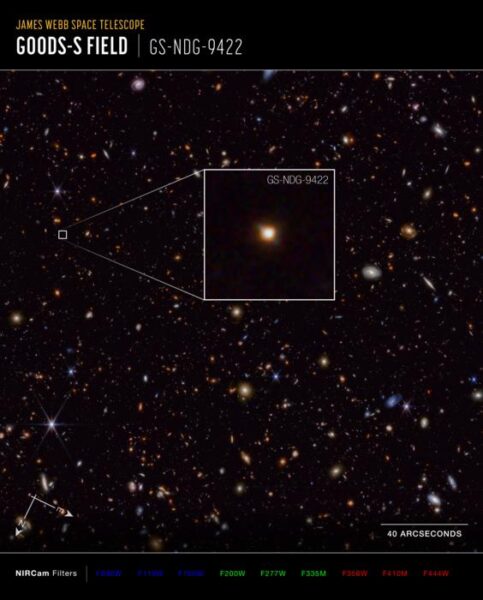Astronomers have made a groundbreaking discovery using the James Webb Space Telescope (JWST), identifying a “weird” galaxy that could revolutionize our understanding of the early Universe. The galaxy, named GS-NDG-9422 (9422), was observed approximately one billion years after the Big Bang and exhibits an unusual light signature never before seen – its gas appears to be shining brighter than its stars.
Summary: The James Webb Space Telescope has discovered a unique galaxy, GS-NDG-9422, from the early Universe where gas outshines stars, potentially providing insights into galaxy evolution shortly after the Big Bang.
Estimated reading time: 6 minutes
A Glimpse into the Cosmic Dawn
This discovery, published in the Monthly Notices of the Royal Astronomical Society, represents a potential missing link in galactic evolution between the Universe’s first stars and the more familiar, well-established galaxies we see today.
Dr. Alex Cameron of the University of Oxford, the lead researcher on the study, described his initial reaction: “My first thought in looking at the galaxy’s spectrum was, ‘that’s weird,’ which is exactly what the Webb telescope was designed to reveal: totally new phenomena in the early Universe that will help us understand how the cosmic story began.”
The JWST, a $10 billion joint project of NASA, ESA, and the Canadian Space Agency, was specifically designed to peer back in time to the early Universe. This discovery showcases its capabilities in unveiling previously unseen cosmic phenomena.
Unraveling the Mystery
To understand this unusual galaxy, Cameron collaborated with Dr. Harley Katz, a theorist from the University of Oxford and the University of Chicago. Their team found that computer models of cosmic gas clouds heated by extremely hot, massive stars – to the point where the gas outshone the stars – closely matched Webb’s observations.
Katz explained, “It looks like these stars must be much hotter and more massive than what we see in the local Universe, which makes sense because the early Universe was a very different environment.”
The researchers estimate that while typical hot, massive stars in the local Universe have temperatures between 70,000 to 90,000 degrees Fahrenheit (40,000 to 50,000 degrees Celsius), the stars in galaxy 9422 are hotter than 140,000 degrees Fahrenheit (80,000 degrees Celsius).
Implications for Our Understanding of Galaxy Evolution
This discovery is particularly intriguing because nebular gas outshining stars is a phenomenon predicted in environments containing the Universe’s first generation of stars, known as Population III stars. However, galaxy 9422 doesn’t contain these primordial stars, as evidenced by its chemical complexity observed in the Webb data.
Katz noted, “We know that this galaxy does not have Population III stars, because the Webb data shows too much chemical complexity. However, its stars are different than what we are familiar with – the exotic stars in this galaxy could be a guide for understanding how galaxies transitioned from primordial stars to the types of galaxies we already know.”
The researchers suspect that galaxy 9422 is undergoing a brief phase of intense star formation within a dense gas cloud, producing numerous massive, hot stars. This star-forming activity is generating so many photons that it causes the surrounding gas cloud to shine exceptionally brightly.
Questions and Future Research
While this discovery is groundbreaking, it raises numerous questions:
- How common are these conditions in galaxies from this early period?
- What can this tell us about even earlier phases of galaxy evolution?
- How do these exotic stars differ from those we observe in the local Universe?
Cameron, Katz, and their colleagues are now working to identify more galaxies with similar characteristics to build a larger population for study. This will help them better understand the conditions in the Universe within the first billion years after the Big Bang.
“It’s a very exciting time, to be able to use the Webb telescope to explore this time in the Universe that was once inaccessible,” Cameron said. “We are just at the beginning of new discoveries and understanding.”
As astronomers continue to analyze data from the James Webb Space Telescope, we can expect more revelations about the early Universe, potentially reshaping our understanding of cosmic evolution and the birth of the first galaxies.
Quiz
- How long after the Big Bang was galaxy GS-NDG-9422 observed?
- What is unusual about the light signature of this galaxy?
- What is the estimated temperature of the stars in galaxy 9422?
Answer Key:
- Approximately one billion years
- Its gas outshines its stars
- Hotter than 140,000 degrees Fahrenheit (80,000 degrees Celsius)
Further Reading:
- James Webb Space Telescope: https://www.nasa.gov/mission_pages/webb/main/index.html
- Early Universe and Galaxy Formation: https://science.nasa.gov/mission/webb/early-universe/
- Population III Stars: https://en.wikipedia.org/wiki/Stellar_population#:~:text=Population%20III%20stars%20are%20a,Woolf%20in%201965.
Glossary of Terms:
- James Webb Space Telescope (JWST): A large infrared telescope launched in 2021 to study the early Universe.
- Population III Stars: The first generation of stars formed after the Big Bang.
- Nebular Gas: Gas found in interstellar space, often associated with star-forming regions.
- Spectroscopy: The study of the interaction between matter and electromagnetic radiation.
- Redshift: The increase in wavelength of light from distant galaxies due to the expansion of the Universe.
Enjoy this story? Get our newsletter! https://scienceblog.substack.com
If our reporting has informed or inspired you, please consider making a donation. Every contribution, no matter the size, empowers us to continue delivering accurate, engaging, and trustworthy science and medical news. Independent journalism requires time, effort, and resources—your support ensures we can keep uncovering the stories that matter most to you.
Join us in making knowledge accessible and impactful. Thank you for standing with us!

